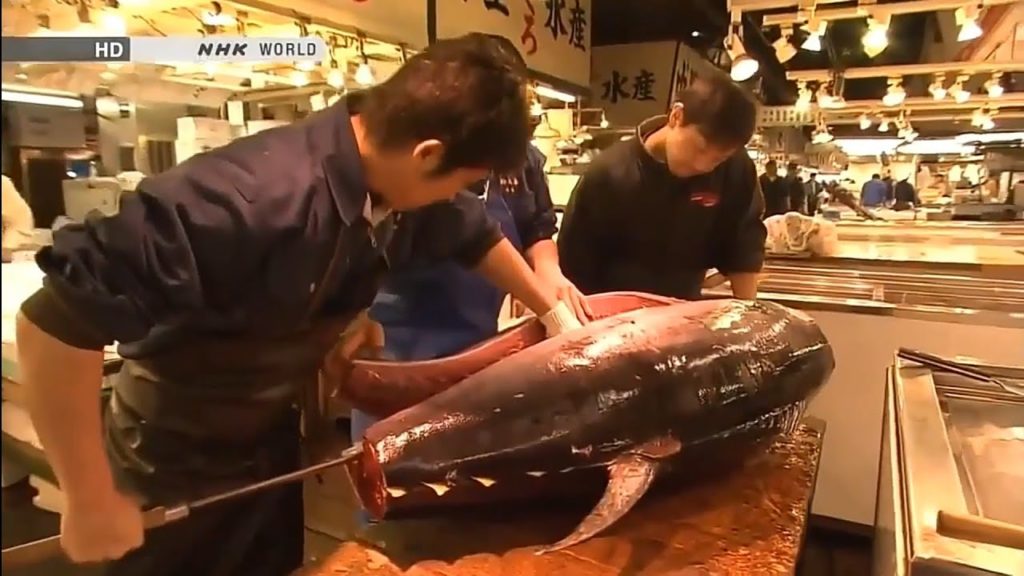The Tsukiji Market (築地市場 Tsukiji shijō), supervised by the Tokyo Metropolitan Central Wholesale Market (東京都中央卸売市場Tōkyō-to Chūō Oroshiuri Shijō) of the Tokyo Metropolitan Bureau of Industrial and Labor Affairs, is the biggest wholesale fish and seafood market in the world and also one of the largest wholesale food markets of any kind.
The market is located in Tsukiji in central Tokyo, between the Sumida River and the upmarket Ginza shopping district. While the inner wholesale market has restricted access to visitors, the outer retail market, restaurants, and associated restaurant supply stores remain a major tourist attraction for both domestic and overseas visitors.
The market is located near the Tsukijishijō Station on the Toei Ōedo Line and Tsukiji Station on the Tokyo Metro Hibiya Line. There are two distinct sections of the market as a whole. The “inner market” (jōnai-shijō) is the licensed wholesale market, where approximately 900 licensed wholesale dealers operate small stalls and where the auctionsand most of the processing of the fish take place. The “outer market” (jōgai-shijō) is a mixture of wholesale and retail shops that sell Japanese kitchen tools, restaurant supplies, groceries, and seafood, and many restaurants, especially sushi restaurants. Most of the shops in the outer market close by the early afternoon, and in the inner market even earlier.
The market handles more than 400 different types of seafood from cheap seaweed to the most expensive caviar, and from tiny sardinesto 300 kg tuna and controversial whale species.[3] Overall, more than 700,000 metric tons of seafood are handled every year at the three seafood markets in Tokyo, with a total value in excess of 600 billion yen (approximately 5.9 billion US dollars on November 24, 2013). The number of registered employees as of 25 January 2010 varies from 60,000 to 65,000, including wholesalers, accountants, auctioneers, company officials, and distributors.
The market opens most mornings (except Sundays, holidays and some Wednesdays) at 3:00 a.m. with the arrival of the products by ship, truck and plane from all over the world. Particularly impressive is the unloading of tons of frozen tuna. The auction houses (wholesalers known in Japanese as oroshi gyōsha) then estimate the value and prepare the incoming products for the auctions. The buyers (licensed to participate in the auctions) also inspect the fish to discern which fish they would like to bid for and at what price.
The auctions start around 5:20 a.m. Bids can only be made by licensed participants. These bidders include intermediate wholesalers (nakaoroshi gyōsha) who operate stalls in the marketplace and other licensed buyers who are agents for restaurants, food processing companies, and large retailers.
The auctions usually end around 10:00 a.m. Afterward, the purchased fish is either loaded onto trucks to be shipped to the next destination or on small carts and moved to the many shops inside the market. There the shop owners cut and prepare the products for retail. In case of large fish, for example tuna and swordfish, cutting and preparation is elaborate. Frozen tuna and swordfish are often cut with large band saws, and fresh tuna is carved with extremely long knives (some well over a meter in length) called oroshi-hōchō, maguro-bōchō, or hanchō-hōchō.
The market is the busiest between 5:30 and 8:00 a.m., and the activity declines significantly afterward. Many shops start to close around 11:00 a.m., and the market closes for cleaning around 1:00 p.m. Tourists may visit the market daily between 5 a.m. and 6:15 a.m. and watch the proceedings from a designated area, except during periods when it is closed to the public.
Because of an increase in sightseers and the associated problems they cause, the market banned all tourists from the tuna auctions on several occasions, including from 15 December 2008 through 17 January 2009,
10 December 2009 through 23 January 2010, and 8 April 2010 through 10 May 2010. After the latest ban that ended in May 2010, the tuna auctions have been re-opened to the public with a maximum limit of 120 visitors per day on a first-come, first-served basis. Visitor entry into the interior wholesale markets is prohibited until after 11 AM. Due to the March 2011 earthquakes all tourists were banned from viewing the tuna auctions till 26 July 2011, from which date it was reopened.
Inspectors from the Tokyo Metropolitan Government supervise activities in the market to enforce the Food Hygiene Law.
History
The first market in Tokyo was established by Tokugawa Ieyasu during the Edo period to provide food for Edo castle (nowadays Tokyo). Tokugawa Ieyasu invited fishermen from Tsukuda, Osaka to Edo to provide fish for the castle. Fish not bought by the castle was sold


AloJapan.com